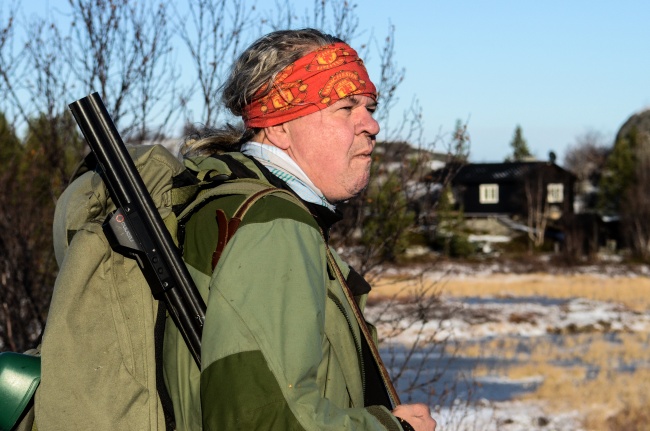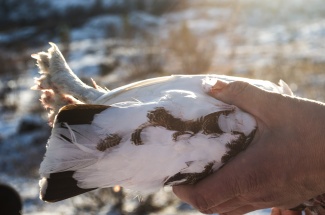The food crisis in the Far North

Global warming could trigger a food crisis in the High North with hunters’ ability to live of the land threatened due to melting ice and migrating species.
The crack of the shotgun smashes through the muffled silence of the snow-covered Korsdalen valley. A white bird, scared up moments before from the low bushes by a bounding Golden Setter, tumbles from the sky. The grouse moves for a few more seconds before a second shot cleaves through the air.
We hadn’t seen the grouse until the dog, Gleipne, sniffed them out of their perches. As he raced ahead bobbing in and out of view his tracker pinged with his location until suddenly the white birds rose like a red flag.
A few minutes earlier, while suiting up Gleipne and attaching a tracking device to his collar Knut Pettersen, a local hunter in Kirkenes, Norway, declared, “This is hunting in the 21st century.”
Technology and human progress

Pettersen’s observation is a nod to how advancing technology, with all the bells and whistles of GPS tracking for the dog and a gun attachment to help him aim, has made being a hunter in a semi-developed part of the High North easier. But where technology and human progress has virtually ended the daily struggle for survival in many part of the world, it has increased it tenfold in others.
Hunting is a way of life for many living in northern climes, but global warming is threatening the future of traditional communities living off of traditional means.
Troubling picture
A UN report, Global Biodiversity Outlook 4, released this month, paints a troubling picture of the environmental future with many of the international climate goals set in 2011 not on track for completion by 2020.
“Changes in environments and wildlife have implications for northern people’s food security and for wildlife and habitat management,” the report cautions.
Across the Arctic northern communities that have been established for hundreds of years are being threatened.
Though some of the biggest culprits of carbon emissions and green house gases are urban centres, the hardest hit communities are the ones who contribute the least to pollution and who rely on the land for their livelihoods.
In Norway alone an estimated 35 000 elk, 40 000 roe deer, 20 000 red deer and 15 000 reindeer are hunted every year. In Canada, Alaska and Greenland, hunters bring home seals, walruses and whales as well.
Unpredictable hunting seasons
But living off the land is not without risks.
Not only are hunting seasons becoming unpredictable, but they are more dangerous too. Unstable ice, unseasonal storms and hard-to-find prey are pushing hunters to take more risks in order to put food on the table.
In the foothills of Sør-Varanger the environmental changes and the threats they pose are not as acute as on ice flows in the Arctic Ocean. But Pettersen, squinting in the bright sun with his tangle of grey hair held back by a red soccer headband – “make sure to get the Manchester United logo,” he instructs – says that over 30 years of hunting he has noticed new species and plant life moving in to the area.
“I have seen on the floor, the vegetations. It’s more with some flowers now than it was before,” says Pettersen. “So for warmer weather…some years will be better [for the birds] but I don’t know how it will be over time.”
For Pettersen, who lives in a larger town in Norway’s Arctic Circle and who isn’t totally reliant on hunting, not making a catch isn’t a major problem. For the indigenous hunters though and for the people living in communities where grocery store prices are out of reach coming home empty handed can mean going hungry.
Extra food, extra income

Pettersen admits the small grouse doesn’t save him much on his grocery bill – with each bullet costing four to five dollars his two-shot catch is already a $10 roast that will only feed one. “It’s not… getting wealthy on this one bird,” says Pettersen.
But bring down a bigger animal like moose or reindeer and your freezer could be stocked through the winter.
Conversely fishing and crabbing, both popular pastimes in the High North, are ways to bring in some extra food or generate some extra income. The father of a local teenage crabber in Kirkenes says his son sells a kilogram of king crab meat for 100 NOK, which is almost $20. However, commercial fisheries are squeezing out private enterprises. The effects of years of unregulated harvests are still being felt today and cast a shadow over the future of living off the land.
“Global temperature increases of 0.4 to 2.6˚C by 2055 and 0.3 to 4.8˚C by 2090 would be accompanied by rising sea levels, changes in precipitation patterns, substantial loss of summer Arctic sea ice and increasing ocean acidification,” states the UN report.
High food prices
In northern communities it’s not uncommon for an average cut of meat to cost upwards of $50 in a grocery store and for a head of lettuce to come in at $15. In the winter fresh produce may not make it into stores for weeks as bad weather holds up the vital supply planes.
Often by the time produce arrives, it’s gone bad.
In Canada the food bank networks supporting vulnerable families says the food situation in the north has reached a crisis point. The Inuit, heavily reliant on food they find on the ice shelf, go hungry more than any other indigenous group in Canada. Nunavut’s food security is the most precarious of any indigenous population living in a developed country.
In Greenland entire indigenous communities have been shut down and the people relocated because they cannot sustain themselves anymore because their hunting season has been halved by global warming.

In Norway the situation is not yet so dire, but for many years indigenous reindeer husbandry has been feeling a squeeze as lands are eaten up and the animals contaminated with pollutants.
The UN report is confirming what people in the High North are already living. A way of life is being winnowed out and a connection with the land, a respect for animals and a relationship with food are all now threatened with extinction.
“It’s very special [the] taste of grouse. That’s one of the reasons we go out and shoot it and take it home and cook it,” says Pettersen. “It’s the taste of wilderness.”
-By Emma Jarratt and James Thomson
Related stories from around the North:
Canada: Addressing northern food insecurity, Blog by Heather Exner-Pirot
Greenland: Researchers must be honest with Arctic peoples about food contaminants: doctor, Eye on the Arctic
Sweden: Demand ups Sweden’s reindeer meat prices, Radio Sweden
United States: Traditional foods making their way onto elders’ plates in Northwest Alaska, Alaska Dispatch



